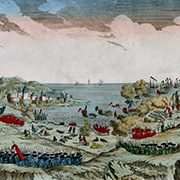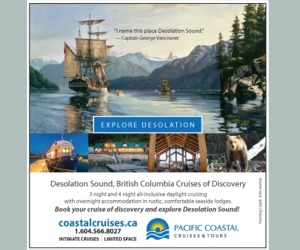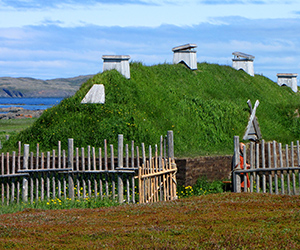CANADA HISTORY - War-New France
1690

On the morning of October 16, 1690, one of the most famous moments of early Canadian history unfolded before the walls of Quebec. The English expedition under Sir William Phips, a former privateer turned royal governor of Massachusetts, had sailed up the St. Lawrence River with a grand plan to capture the heart of New France. Phips, emboldened by a series of successes and driven by the aggressive spirit of the New England colonies, believed that the fall of Quebec would be swift and decisive. He underestimated the determination of the city's defenders, led by the formidable Governor Louis de Buade, Comte de Frontenac.
That morning, Phips sent a demand for Quebec's surrender, hoping to avoid a protracted and bloody battle. The letter, composed by four chaplains accompanying the expedition, was designed to convey the moral authority of King William III and the righteousness of the English cause. To deliver the message, Phips selected Major Thomas Savage, a man of 50, despite being referred to in some accounts as "young Thomas Savage" to distinguish him from his father. The decision to send a formal envoy, a mark of the confidence the English had in their position, would soon become a legendary episode in the history of New France.
Upon arriving at Fort St. Louis, Savage was blindfolded and led through the gates into the heart of the citadel. He later found himself in what a Boston merchant, James Lloyd, described as a "stately hall full of brave martial men." Savage’s task was to present Phips' ultimatum, demanding Quebec's surrender within an hour. The letter from the chaplains was infused with the religious zeal of the New Englanders, but it carried the threat of military action if Frontenac did not comply. Phips expected this show of force would intimidate the defenders and bring a quick capitulation.
But Frontenac—the seasoned soldier and veteran of European wars—was not a man to be easily cowed. Dressed in full military regalia, surrounded by his officers, and with the guns of Quebec at his back, he exuded defiance. Without hesitation, he delivered his famous reply, a response that would become ingrained in Canadian lore: "I will not keep you waiting an hour. I do not acknowledge King William as my sovereign, and I will answer your General only with the mouths of my cannon and musketry." When Savage requested a written reply to bring back to Phips, Frontenac again dismissed him curtly, refusing to engage in further negotiation. Savage, now well aware of the determination of Quebec's defenders, was returned to his boat.
The news of Frontenac’s refusal stunned the English. According to Lloyd, Phips' men had been prepared by their chaplains to expect a more favorable outcome, and Frontenac’s bold rejection "startled" them. Phips, for all his bravado, now faced a difficult decision. He had embarked on the expedition with high hopes, but the failure of his demand for surrender forced him to confront the harsh reality of Quebec's formidable defenses. The city was well-fortified, and its natural position on the cliffs of the St. Lawrence River made it one of the most impregnable strongholds in North America.
Undeterred by the rebuff, the English held a council of war to devise a plan of attack. Major John Walley, Phips' second-in-command, along with Savage, were among those tasked with executing the next phase of the operation. The strategy they devised, while ambitious, was complicated—perhaps too complicated for the untrained and inexperienced forces at their disposal. The English planners, much like those who would face similar challenges during the Dieppe Raid centuries later, were confronted with the difficulty of assaulting a heavily fortified position from both land and sea.
The plan called for a frontal attack on Quebec, combined with an attempted flanking maneuver. The bulk of the New England troops would be landed on the Beauport shore, east of the city, at a place called La Canardière. From there, they would cross the St. Charles River, which was fordable at low tide, using the fleet’s boats to transport their field artillery to the opposite bank. Once across, the troops would advance up the cliffs toward Quebec, while the fleet's warships would provide covering fire and attempt to land additional soldiers directly under the city's guns. Walley outlined the details of this plan in his journal, noting that as soon as the English forces reached the heights above the city and signaled their success by setting fire to a house, the warships would land 200 more men to mount a direct assault on Quebec’s walls.
But the weakness of this plan was its complexity. It required a high degree of coordination between the land and naval forces—something the New England militia, with their limited training and discipline, were not prepared to achieve. Moreover, Quebec's defenders were well-prepared. Frontenac had mobilized all available forces, including French regulars, militia, and Indigenous allies, and had fortified the city’s key positions. The English troops, though numerically superior, lacked the experience and cohesion necessary for such a coordinated attack.
As the battle unfolded, these weaknesses became apparent. The English landing was met with stiff resistance, and the attempt to ford the St. Charles proved more difficult than anticipated. The fleet’s warships, struggling to navigate the river’s tricky currents and shoals, failed to land reinforcements in time to support the ground assault. Communication between the land and naval forces broke down, and the New Englanders, unable to bring their artillery into position, found themselves outgunned and outmaneuvered.
Phips' attempt to capture Quebec, much like the ill-fated Dieppe Raid centuries later, ended in failure. The English forces, demoralized and disorganized, were forced to withdraw, leaving Quebec in the hands of Frontenac and the defenders of New France. This bold defense of Quebec not only preserved French control of the St. Lawrence but also solidified Frontenac’s reputation as one of the most capable and determined leaders in Canadian history.
Cite Article : Reference: www.canadahistory.com/sections/documents/documents.html
Source: NA



